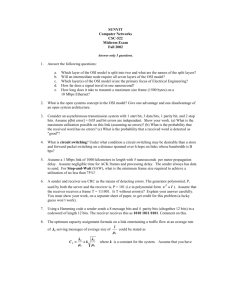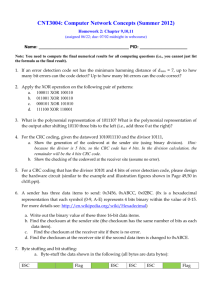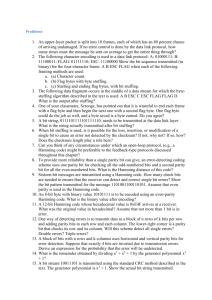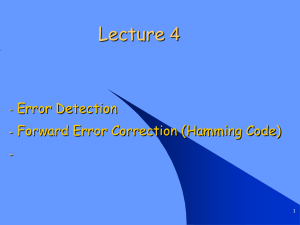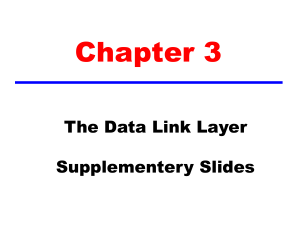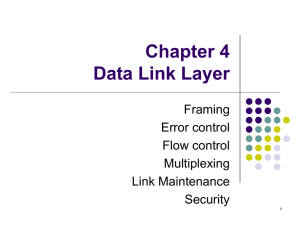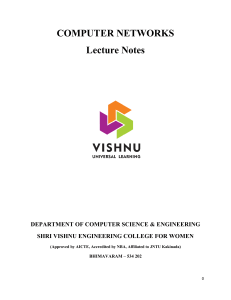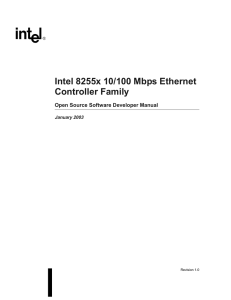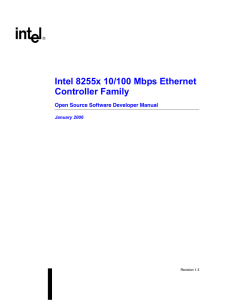2 - People.vcu.edu
advertisement
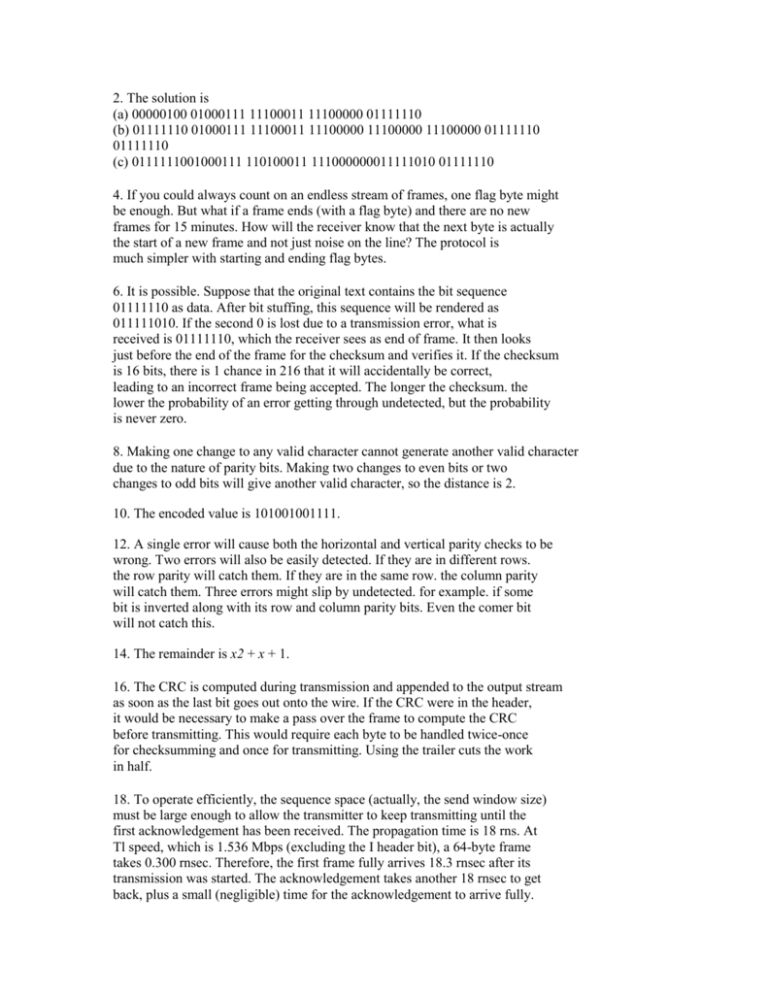
2. The solution is (a) 00000100 01000111 11100011 11100000 01111110 (b) 01111110 01000111 11100011 11100000 11100000 11100000 01111110 01111110 (c) 0111111001000111 110100011 111000000011111010 01111110 4. If you could always count on an endless stream of frames, one flag byte might be enough. But what if a frame ends (with a flag byte) and there are no new frames for 15 minutes. How will the receiver know that the next byte is actually the start of a new frame and not just noise on the line? The protocol is much simpler with starting and ending flag bytes. 6. It is possible. Suppose that the original text contains the bit sequence 01111110 as data. After bit stuffing, this sequence will be rendered as 011111010. If the second 0 is lost due to a transmission error, what is received is 01111110, which the receiver sees as end of frame. It then looks just before the end of the frame for the checksum and verifies it. If the checksum is 16 bits, there is 1 chance in 216 that it will accidentally be correct, leading to an incorrect frame being accepted. The longer the checksum. the lower the probability of an error getting through undetected, but the probability is never zero. 8. Making one change to any valid character cannot generate another valid character due to the nature of parity bits. Making two changes to even bits or two changes to odd bits will give another valid character, so the distance is 2. 10. The encoded value is 101001001111. 12. A single error will cause both the horizontal and vertical parity checks to be wrong. Two errors will also be easily detected. If they are in different rows. the row parity will catch them. If they are in the same row. the column parity will catch them. Three errors might slip by undetected. for example. if some bit is inverted along with its row and column parity bits. Even the comer bit will not catch this. 14. The remainder is x2 + x + 1. 16. The CRC is computed during transmission and appended to the output stream as soon as the last bit goes out onto the wire. If the CRC were in the header, it would be necessary to make a pass over the frame to compute the CRC before transmitting. This would require each byte to be handled twice-once for checksumming and once for transmitting. Using the trailer cuts the work in half. 18. To operate efficiently, the sequence space (actually, the send window size) must be large enough to allow the transmitter to keep transmitting until the first acknowledgement has been received. The propagation time is 18 rns. At Tl speed, which is 1.536 Mbps (excluding the I header bit), a 64-byte frame takes 0.300 rnsec. Therefore, the first frame fully arrives 18.3 rnsec after its transmission was started. The acknowledgement takes another 18 rnsec to get back, plus a small (negligible) time for the acknowledgement to arrive fully. In all, this time is 3u.3 rnsec. The transmitter must have enough window space to keep going for 36.3 rnsec. A frame takes 0.3 rns, so it takes 121 frames to fill the pipe. Seven-bit sequence numbers are needed. 20. Let the sender's window be (S[, Su) and the receiver's window size be W. The relations that must hold are: 22. Yes. It might lead to deadlock. Suppose that a batch of frames arrived correctly and were accepted. Then the receiver would advance its window. Now suppose that all the acknowledgements were lost. The sender would eventually time out and send the first frame again. The receiver would send a NAK. Suppose that this were lost. From that point on, the sender would keep timing out and sending a frame that had already been accepted, but the receiver would just ignore it. Setting the auxiliary timer results in a correct acknowledgement being sent back eventually instead, which resynchronizes. 24. It would defeat the purpose of having NAKs, so we would have to fall back to timeouts. Although the performance would degrade, the correctness would not be affected. The NAKs are not essential. 26. Yes. The maximum receive window size is 4. 28. No. This implementation fails. WithMaxSeq=4, we get NrBufs=2. The even sequence numbers use buffer 0 and the odd ones use buffer 1. This mapping means that frames 4 and 0 both use the same buffer. Suppose that frames 0-3 are received and acknowledged. The receiver's window now contains 4 and O. If 4 is lost and 0 arrives, it will be put in buffer 0 and arrived[O] set to true. The loop in the code for FrameArrival will be executed once, and an out-of-order message delivered to the host. This protocol requires MaxSeq to be odd to work properly. However, other implementations of sliding window protocols do not all have this property 30. With a 50-kbps channel and 8-bit sequence numbers, the pipe is always full. The number of retransmissions per frame is about 0.01. Each good frame wastes 40 header bits, plus 1% of 4000 bits (retransmission), plus a 40-bit NAK once every 100 frames. The total overhead is 80.4 bits per 3960 data bits, for a fraction 80.4/(3960 + 80.4) =1.99 percent. 32. The propagation speed in the cable is 200,000 km/sec, or 200 km/msec, so a 100-km cable will be filled in 500 microsec. Each Tl frame is 193 bits sent in 125 microsec. This corresponds to four frames, or 772 bits on the cable. 34. The firing sequence is 10, 6, 2, 8. It corresponds to acceptance of an even frame, loss of the acknowledgement, timeout by the sender, and regeneration of the acknowledgement by the receiver. 36. PPP was as clearly designed to be implemented in software, not in hardware as HDLC nearly always is. With a software implementation, working entirely with bytes is much simpler than working with individual bits. In addition, PPP was designed to be used with modems, and modems accept and transmit data in units of 1 byte, not 1 bit. 38 Test the program By typing Generator < file | verifier You should see that the message is correct, but by typing Generator < file | alter arg |verifier You should get the error message
